weather.com meteorologists
The 2021 Atlantic hurricane season is predicted to be more active than usual, according to an outlook released Thursday by NOAA's Climate Prediction Center.
The NOAA outlook calls for 13 to 20 named storms, six to 10 hurricanes and three to five major hurricanes. A major hurricane is one that is Category 3 or higher (115-plus-mph winds) on the Saffir-Simpson Hurricane Wind Scale.
This forecast is above the 30-year average (1991 to 2020) of 14 named storms, seven hurricanes and three major hurricanes.
NOAA's outlook is in agreement with The Weather Company, an IBM Business, which calls for 19 named storms, eight hurricanes and four major hurricanes.
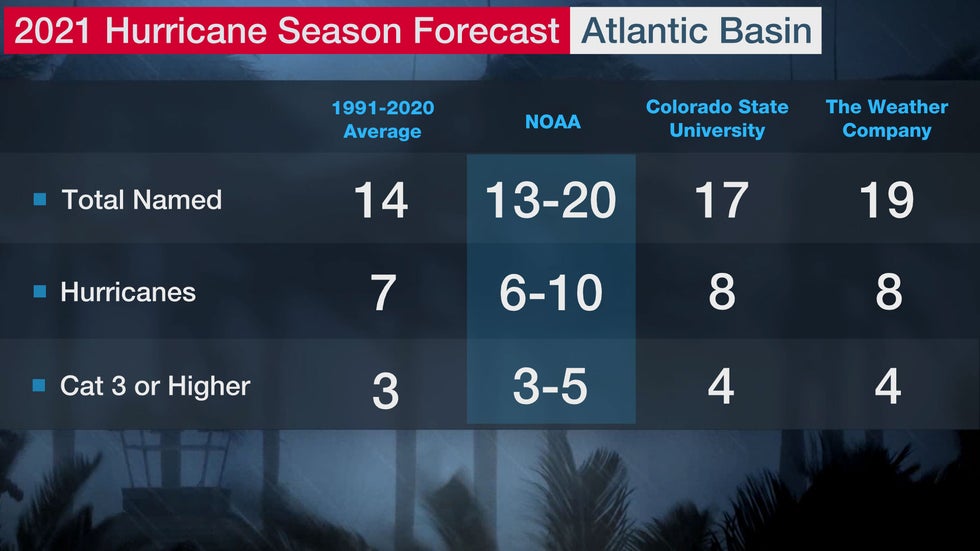 Current 2021 hurricane season outlooks from NOAA, Colorado State University and The Weather Company, compared to a 1991-2020 average season
Current 2021 hurricane season outlooks from NOAA, Colorado State University and The Weather Company, compared to a 1991-2020 average seasonNOAA's outlook is based on a number of climate factors, including the El Niño-Southern Oscillation (ENSO) and sea-surface temperatures in the Atlantic Basin.
ENSO conditions are expected to be either neutral (neither El Niño nor La Niña) or trend toward La Niña, which means El Niño likely won't be present to suppress hurricane activity.
Warmer than average sea-surface temperatures are expected in the tropical Atlantic Ocean and the Caribbean Sea. The warmer water temperatures, combined with weaker tropical Atlantic trade winds and an enhanced west African monsoon, increase the odds of an above-average hurricane season.
"Although NOAA scientists don't expect this season to be as busy as last year, it only takes one storm to devastate a community," said Ben Friedman, acting NOAA administrator. "The forecasters at the National Hurricane Center are well-prepared with significant upgrades to our computer models, emerging observation techniques and the expertise to deliver the life-saving forecasts that we all depend on during this, and every, hurricane season."
One of those emerging observation techniques is new drones that will be launched from NOAA Hurricane Hunter aircraft to fly into the lower part of hurricanes.
NOAA's outlook is for overall activity expected during the hurricane season and is not a landfall forecast. It will update the 2021 seasonal outlook in August prior to the historical peak of the Atlantic season.
(MORE: 2021 Atlantic Hurricane Season Names)
A record 30 named storms formed in the 2020 hurricane season, 14 of which became hurricanes.
The NOAA and The Weather Company forecasts are similar to the April outlook issued by Colorado State University.
Here are some questions and answers about what these outlooks mean.
What Do Forecasters Examine?
One of the ingredients that meteorologists, including those at NOAA, The Weather Company and CSU, analyze going into the hurricane season is the water temperature of the Atlantic, Caribbean and Gulf of Mexico.
Much of the Atlantic Basin's waters are already warmer than average, particularly in the subtropics near Bermuda and off parts of the East Coast. Parts of the Gulf of Mexico are also warmer than average, although portions of the northern Gulf are close to average.
 Sea surface temperature anomalies as of May 20, 2021.
Sea surface temperature anomalies as of May 20, 2021.The current ocean temperature anomalies in the Atlantic Basin "correlate relatively well with what is typically seen in active Atlantic hurricane seasons," said Dr. Phil Klotzbach, who leads the CSU Tropical Meteorology Project.
But the warmth isn't nearly the magnitude we saw a year ago.
"Current Atlantic SSTs (sea-surface temperatures), when taken in aggregate, are at lower levels than last year," said Dr. Todd Crawford, chief meteorologist at The Weather Company.
Shop Hurricane Preparedness Gear at Sierra Trading Post (SPONSORED)
However, the recent upper-level pattern in the North Atlantic, with a blocking high pressure near Greenland, has helped to increase sea surface temperatures in the Atlantic. This pattern may persist a bit longer, which could lead to warmer water temperatures during hurricane season and higher tropical numbers, Crawford noted.
Climate models suggest that most of the basin, if not all of it, will be warmer than average at the peak of hurricane season.
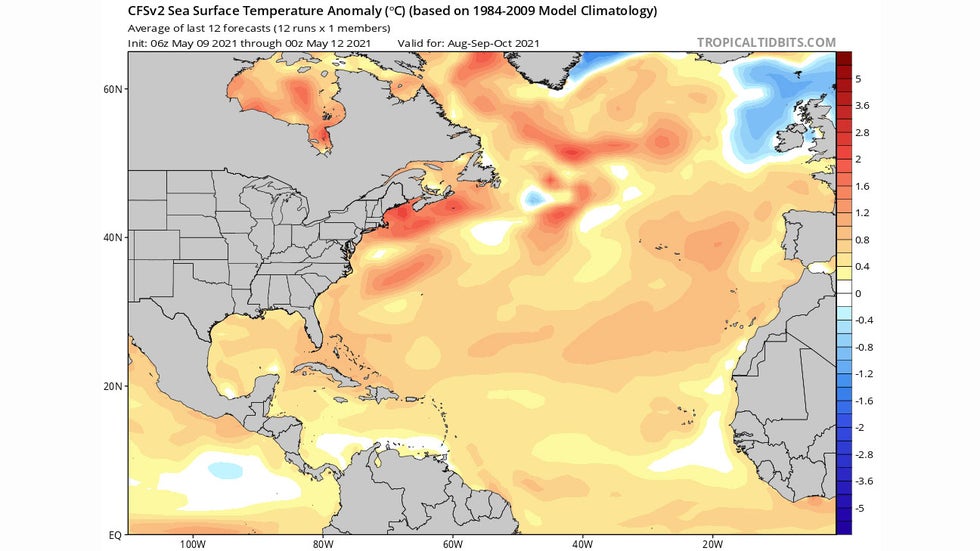 Forecast sea-surface temperature anomalies (in degrees Celsius) for August-October 2021 from the CFSv2 model, as of early May 2021.
Forecast sea-surface temperature anomalies (in degrees Celsius) for August-October 2021 from the CFSv2 model, as of early May 2021.An above-average number of tropical storms and hurricanes is more likely if temperatures in the main development region (MDR) between Africa and the Caribbean Sea are warmer than average. Conversely, below-average ocean temperatures can lead to fewer tropical systems than if waters were warmer.
Assuming atmospheric factors are favorable, warmer waters in the MDR allow tropical waves, the formative engines that can eventually become tropical storms, to get closer to the Caribbean and the U.S.
The prevalence of wind shear and dry air across the Atlantic will also need to be watched over the next six to eight months.
How much dry air rolls off the coast of Africa is another thing that will need to be monitored. Even if water temperatures are boiling and there is little wind shear, dry air can still disrupt developing tropical cyclones and even prohibit their birth.
Hurricanes need a rather precise set of ingredients to come together in order for them to fester, so all of these ingredients will need to be monitored this year.
How Much of a Role Will La Niña Play?
El Niño/La Niña, the periodic warming/cooling of the equatorial eastern and central Pacific Ocean, can shift weather patterns and influence winds in the Atlantic Basin during hurricane season.
La Niña has ended and NOAA's Climate Prediction Center noted that ENSO-neutral conditions (neither El Niño nor La Niña) will likely continue through the summer. However, there could be a trend toward La Niña this fall.
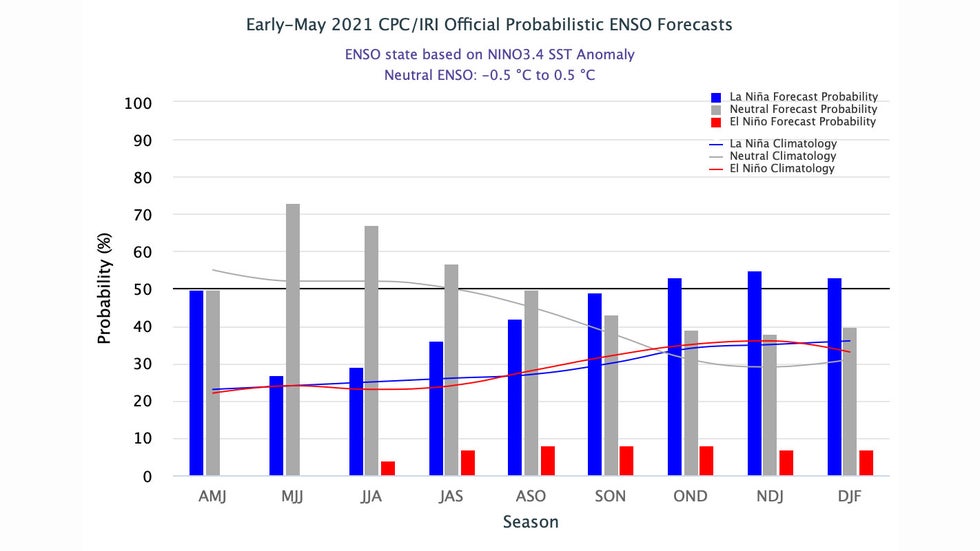 Early May 2021 model-based forecast probabilities for La Niña (blue bars), neutral (gray bars) and El Niño (red bars) into early 2022.
Early May 2021 model-based forecast probabilities for La Niña (blue bars), neutral (gray bars) and El Niño (red bars) into early 2022.La Niñas typically correspond to more active hurricane seasons because the cooler Eastern Pacific water produces weaker trade winds and less wind shear in the Caribbean Sea that would otherwise rip apart hurricanes and tropical systems trying to develop.
Such was the case in 2020, when La Niña intensified to become the strongest in 10 years. This was one factor behind a record 30 named storms in 2020.
But while La Niña may have ended, its influence on the atmosphere may not fade in time for hurricane season.
Get This First Aid Kit And Be Prepared For The Storm (SPONSORED)
Warm water near Indonesia may continue to drive rising motion and increased thunderstorm activity there and contribute to an overall favorable atmospheric pattern for Atlantic hurricanes similar to a La Niña.
Think of this lingering atmospheric pattern as the ghost of La Niña.
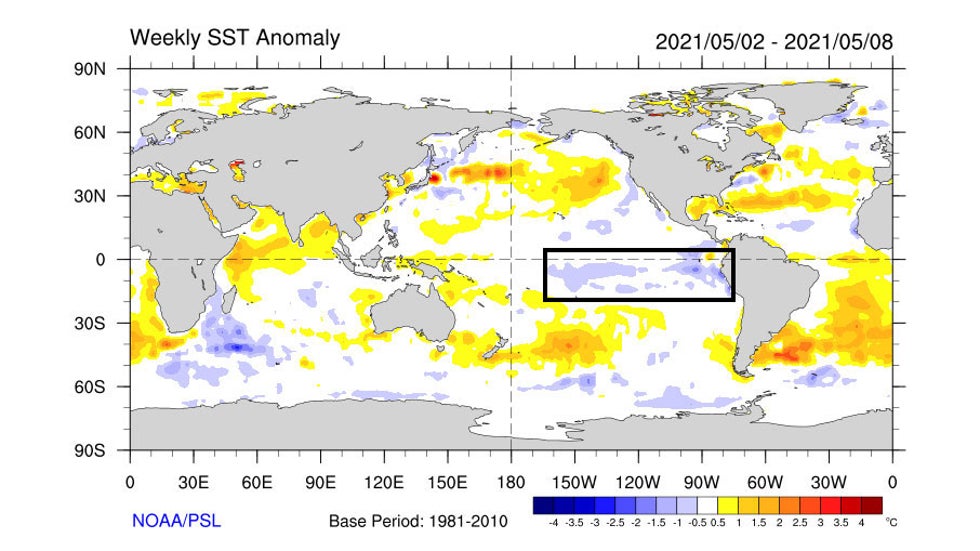 The blue area highlighted shows the fading La Niña.
The blue area highlighted shows the fading La Niña.The status of the El Niño-Southern Oscillation (ENSO) is notoriously difficult to predict. This is especially true from February to May, when the "spring predictability barrier" is in play – a period when forecast skill is lower than the rest of the year.
Despite that, El Niño probably isn't on the table this season.
"Our best estimate is that we will likely not have El Niño conditions for the peak of the Atlantic hurricane season," Klotzbach said.
Stronger El Niños tend to correspond to less active hurricane seasons because the warmer Eastern Pacific water produces more shearing winds and stronger low-level winds in the Caribbean Sea that can rip apart hurricanes and systems that try to develop. They can also lead to a sinking motion over at least part of the Atlantic Basin, which also suppresses tropical cyclones.
What Does This Mean for the United States?
A record 11 storms made landfall in the U.S. in 2020, including six hurricanes: Hanna, Isaias, Laura, Sally, Delta and Zeta.
(MORE: Laura, Entire Greek Alphabet Retired Following 2020 Hurricane Season)
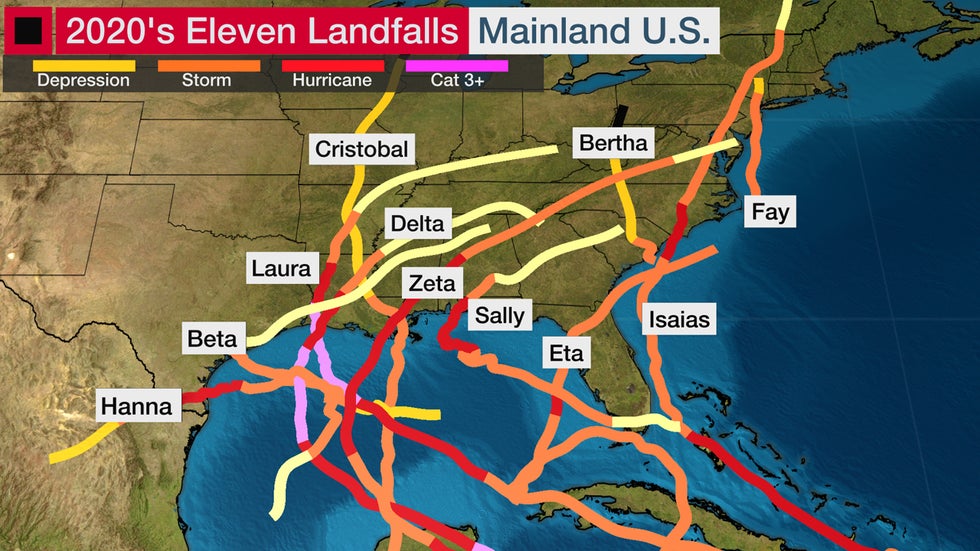
That's well above the average of one to two hurricane landfalls each season, according to NOAA's Hurricane Research Division.
"We anticipate an above-average probability for major hurricanes making landfall along the continental United States coastline and in the Caribbean," said Klotzbach. "As is the case with all hurricane seasons, coastal residents are reminded that it only takes one hurricane making landfall to make it an active season for them. They should prepare the same for every season, regardless of how much activity is predicted."
Despite the record 2020 season, there isn't necessarily a strong correlation between the number of storms or hurricanes and U.S. landfalls in any given season. One or more of the named storms predicted to develop this season could hit the U.S., or none at all.
Some past hurricane seasons have been inactive but included at least one notable landfall.
The 1992 season produced only six named storms and one subtropical storm. However, one of those named storms was Hurricane Andrew, which devastated South Florida as a Category 5 hurricane.
In 1983, there were only four named storms, but one of them was Alicia. The Category 3 hurricane hit the Houston-Galveston area and caused almost as many direct fatalities there (21) as Andrew did in South Florida (26).
On the other hand, the 2010 Atlantic season was very active, with 19 named storms and 12 hurricanes. Despite the high number of storms that year, no hurricanes and only one tropical storm made landfall in the U.S.
In other words, a season can deliver many storms but have little impact, or deliver few storms and have one or more hitting the U.S. coast with major impact.
The bottom line is it's impossible to know for certain if a U.S. hurricane strike will occur this season. Keep in mind that even a weak tropical storm hitting the U.S. can cause major impacts, particularly if it moves slowly and its rainfall triggers flooding.
The Weather Company’s primary journalistic mission is to report on breaking weather news, the environment and the importance of science to our lives. This story does not necessarily represent the position of our parent company, IBM.
The Weather Company’s primary journalistic mission is to report on breaking weather news, the environment and the importance of science to our lives. This story does not necessarily represent the position of our parent company, IBM.

No comments:
Post a Comment